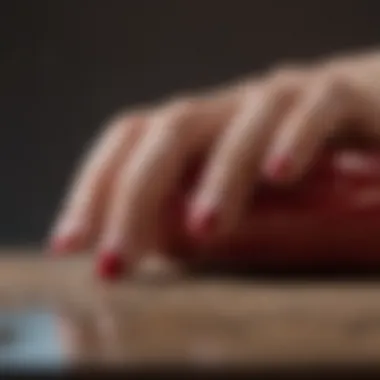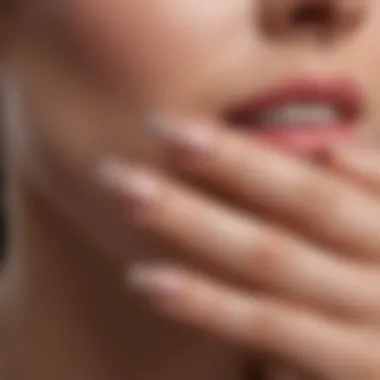Effective Methods to Remove Shellac Nails at Home


Intro
Removing shellac nails at home can feel daunting, yet it is a process that, with the right knowledge, can be executed with ease and safety. Many people opt for shellac nails due to their long-lasting power and glossy finish, but when it comes time to remove them, one must be cautious. This guide will provide a comprehensive overview of the methods, tools, and aftercare essential for successful shellac nail removal. By understanding the intricacies of all the steps involved, you can maintain the health of your natural nails and avoid damage to your nail beds.
Knowing how to properly remove shellac nails is important for beauty enthusiasts and anyone wishing to take control of their nail care regimen. This article covers:
- The essential tools required
- Step-by-step techniques for removal
- Aftercare practices that promote nail health
With these insights, you can approach shellac removal confidently, ensuring your nails remain beautiful even after the shellac is gone.
Beauty Tips and Tricks
Achieving a successful shellac removal process goes hand-in-hand with taking care of your nails and skin. Here are some effective tips:
- Stay patient: Rushing the process can lead to nail damage. Give yourself adequate time to remove shellac properly.
- Hydrate your nails: Keep your nails moisturized before and after removal to prevent dryness.
- Warm your tools: A warm nail file can ease the process of buffing the shellac off.
Essential Tools for Shellac Removal
Before beginning the removal process, gather your materials. You will need:
- Acetone-based nail polish remover: This is key for dissolving the shellac coating.
- Cotton balls or pads: These will hold the acetone against your nails.
- Aluminum foil: Used to wrap your fingers, holding the cotton on the nails.
- Nail file and buffer: To gently buff away the top layer.
- Cuticle oil or hand cream: For post-removal hydration.
Always remember to use high-quality products to ensure effective results while minimizing the risk of damage.
Step-by-Step Removal Process
- File the top layer: Gently buff the shiny top coat of the shellac. This helps the acetone penetrate better.
- Soak cotton in acetone: Saturate cotton balls or pads in acetone-enriched remover.
- Wrap fingers: Place the soaked cotton on the nails, and wrap each finger with aluminum foil to hold it in place.
- Let it sit: Allow the wraps to stay on for 10-15 minutes.
- Check the nails: Remove the foil and cotton. The shellac should be soft. Gently push it off with a cuticle pusher.
- Buff and clean: Buff any remaining residue and wash your hands.
- Hydrate: Apply cuticle oil and hand cream to nourish your nails and skin.
Aftercare
After successfully removing your shellac nails, focus on post-care. Some points to ensure healthy nails include:
- Apply cuticle oil daily to nourish the nail bed.
- Avoid harsh chemicals in the following days to allow nails to recover.
- Give your nails a break from polish or any enhancements to strengthen them naturally.
Understanding Shellac Nails
Understanding shellac nails is key for anyone deciding to engage in at-home nail care. Shellac, a hybrid nail product, combines the qualities of gel and traditional nail polish. This understanding is important not only for application but also for the removal process, which can significantly impact the health of one's natural nails.
In this article, we will delve into different aspects of shellac nails. We will define what they are and how they differ from regular nail polish. By doing so, we aim to provide insight that helps individuals in making better decisions regarding their nail care routines. This knowledge can also aid in recognizing when to seek professional help, especially in cases where improper removal leads to damage.
What are Shellac Nails?
Shellac nails are a form of cosmetic enhancement that involves applying a special, durable nail polish that is cured under ultraviolet light. This product was developed by CND (Creative Nail Design) and offers a long-lasting, chip-free finish. The application process typically includes a base coat, color coat, and a top coat, each cured with UV light. The result is a glossy, resilient finish that remains intact for weeks.
The primary appeal of shellac is its durability, providing an alternative for those who seek a long-lasting manicure without the upkeep a regular polish requires. Many beauty enthusiasts prefer shellac due to this longevity and the vibrant colors available.
Difference Between Shellac and Regular Nail Polish
The differences between shellac and regular nail polish are notable and worth understanding. Regular nail polish generally dries by evaporation of solvents, making it swift and easy to apply. However, it wears off relatively quickly and can chip within a few days, requiring frequent touch-ups.
In contrast, shellac is designed for longevity. Here are some critical distinctions:
- Durability: Shellac lasts much longer than traditional polish, often up to three weeks without chipping.
- Curing: Shellac requires curing under UV light, while regular polish dries by air.
- Removal: Shellac demands a more careful and extended removal process using acetone, whereas regular polish can be taken off easily with standard nail polish remover.
Understanding these differences can inform better choices for nail care, helping to preserve natural nails and avoid unnecessary damage during removal.
Reasons for Shellac Removal


Understanding the rationale behind shellac nail removal is essential for anyone who frequently indulges in this nail treatment. Shellac nails provide a polished look, but keeping them on for too long can lead to potential issues.
Maintenance and Nail Health
Maintaining nail health is a primary reason for the removal of shellac. While the finish is attractive, shellac can weaken the natural nail over time. This occurs due to the bonding agents used in shellac applications. When nails are covered for extended periods, they may lack the necessary exposure to air and moisture, leading to brittleness and peeling. Regular removal and care allow for the natural renewal process of nails.
Furthermore, ongoing use without breaks can lead to fungal infections. Keeping nails covered traps moisture, creating an ideal environment for bacteria. Thus, periodically removing shellac is crucial to prevent these adverse effects and foster healthier nails.
Changing Trends and Styles
The world of beauty and nail design often witnesses rapid changes in trends. What was once a fashionable shellac color may no longer appeal weeks later. Women and men alike often want to switch colors to match their outfits or occasions.
Shellac enables creativity, yet this variability also contributes to a need for frequent removal. Staying current with styles ensures that individuals can express their personal taste. People often prefer to experiment with seasonal colors or new designs, which necessitates removal. Thus, a balanced approach of wear and removal allows for both creativity and self-expression in the ever-evolving beauty landscape.
Preparation for Removal
Before you commence the process of removing shellac nails, adequate preparation is essential. Not only does it play a significant role in the effectiveness of the removal process, but it also minimizes potential damage to the natural nails. Taking the time to gather necessary materials and set up your environment ensures a smooth experience. Better preparation leads to efficiency and increases the likelihood of preserving the health of your nails.
Essential Tools Required
To successfully remove shellac nails at home, specific tools are non-negotiable. Each tool serves a unique purpose in the overall procedure, making their selection vital.
Acetone
Acetone is a solvent commonly used in nail care that dissolves shellac effectively. Its strong characteristics make it the primary choice for nail removal. Acetone penetrates the layers of shellac nail polish, breaking it down efficiently, which is crucial for achieving a clean removal. However, it can be drying and may cause irritation for some. Therefore, using it appropriately and following up with moisturizing products is advisable.
Cotton Balls or Pads
Cotton balls or pads are integral in the process. They act as a medium for applying acetone directly onto the nails. Their softness ensures that they won’t scratch or damage the nail surface. Moreover, they absorb the acetone well, allowing for even application. Choosing high-quality cotton pads can enhance the removal experience by offering better saturation without falling apart.
Aluminum Foil
Aluminum foil is used to wrap the nails, helping to create a barrier that retains heat and enhances acetone absorption. This facilitates the process, making shellac easier to lift off the nail. Its lightweight nature and flexibility make it a practical choice. However, care must be taken when wrapping to ensure that it stays secure, preventing acetone from evaporating.
Nail Buffer
A nail buffer is helpful, especially post-removal. It works to smooth the natural nail surface after shellac is removed, eliminating any residual roughness. Buffers come in various grits, making them versatile for different nail care tasks. Caution is needed, as using too much pressure could thin the natural nail.
Cuticle Oil
Using cuticle oil post-removal is essential. It replenishes moisture lost during the acetone exposure, aiding in nail recovery. Cuticle oil helps keep the nails and surrounding skin healthy and hydrated, which is necessary for nail growth. Regular application can prevent dryness and brittleness, ensuring that your nails remain strong. Although often overlooked, incorporating cuticle oil into your routine can lead to long-term benefits.
Setting Up Your Workspace
Creating a designated area for shellac nail removal can significantly enhance the efficiency of the process. A clean, well-lit space prevents distractions and keeps tools organized. Ideally, choose a flat surface where you can comfortably sit. Lay out all tools within easy reach to avoid interruptions. Consider using a towel to catch any spills, protecting your workspace while keeping it tidy.
Methods of Removal
The methods for removing shellac nails at home are crucial for ensuring both efficiency and the health of your nails. Various techniques exist, each with its unique benefits and considerations. Understanding these methods allows you to select the most suitable approach based on your preferences and nail condition. By following proper procedures, you can avoid potential damage and achieve a clean finish.
Soaking Method
The soaking method is one of the most popular techniques for shellac removal. This approach typically involves using acetone to dissolve the shellac polish. Acetone is a powerful solvent that penetrates the layers of nail polish effectively.
Steps for the Soaking Method:
- Gather your materials: You will need acetone, cotton balls or pads, and aluminum foil.
- Prepare the nails: Clip and file the nails slightly to reduce the polish surface area.
- Soak the cotton: Saturate the cotton with acetone.
- Apply to the nails: Place the soaked cotton on each nail and secure it with a piece of aluminum foil to keep the cotton in place.
- Wait: Leave the cotton on for about 10-15 minutes.
- Remove it: After soaking, gently wipe away the melted shellac using the cotton.
This method is effective but may be drying to the nails. It is essential to hydrate them afterward with cuticle oil or a nourishing nail treatment.


Filing Method
The filing method sees some preferring to gradually reduce the thickness of the shellac layers using a nail file. This approach may take longer than soaking but can offer more control over the process.
Steps for the Filing Method:
- Select the right tools: Use an 180-grit nail file or buffer.
- Lightly buff the nail surface: Start by gently filing the top layer of the shellac. Avoid excessive pressure, which can harm your natural nails.
- Continue filing: Work evenly across the nail until you see the underlying layers of polish.
- Use a buffer: After reducing the polish, use a buffer to smooth the nail surface.
The filing method can be less drying but requires caution to avoid excessive filing, which may damage the nail bed.
Combination Approach
The combination approach utilizes both the soaking and filing techniques to remove shellac nails effectively. This method can be seen as the best of both worlds, allowing for a thorough removal while minimizing potential damage.
Steps for Combination Approach:
- File the top layer: Begin with the filing method to thin out the shellac polish gently. This makes the subsequent soaking process more efficient.
- Soak with acetone: Follow by soaking your nails, as in the first method, to dissolve any remainder of the polish.
- Remove the shellac: Once the acetone has worked, use a gentle motion to wipe off the remaining shellac.
This approach aids in lessening drying effects and offers control throughout the process. Additionally, post-care is equally important regardless of the method used.
Step-by-Step Removal Guide
The process of removing shellac nails at home is critical for maintaining the health of your natural nails. The importance of following a step-by-step guide cannot be overstated. Improper removal can lead to weakened nails, peeling, or even damage to the nail bed. A structured approach not only ensures that each phase is executed properly but also enhances your overall experience. By adhering to a clear sequence of actions, you mitigate the risks involved and ensure that the removal is as smooth as possible.
Preparing Your Nails
Before initiating the removal of shellac nails, it is essential to prepare your nails adequately. Start by ensuring your nails are clean and dry. Remove any excess polish using a standard nail polish remover. After this, trim your nails to a manageable length and shape them if needed. This step will help reduce any stress during the removal process. Additionally, consider lightly buffing the surface of the nails with a nail buffer. This will break the top coat and allow the acetone to penetrate more effectively, facilitating the removal process.
Applying Acetone with Cotton
Acetone is pivotal in the removal of shellac nails. Take a cotton ball or pad and saturate it with acetone without oversaturating it to avoid excess dripping. Place the soaked cotton directly on the nail, ensuring full coverage. This action is significant as it allows acetone to dissolve the shellac, leading to an easier removal process. Make sure you do this slowly and carefully; avoid splashing acetone on your skin. Ensure that the cotton adheres well to the nail to maximize effectiveness.
Wrapping Method with Foil
Once the acetone is applied, the next step involves wrapping the nails with aluminum foil. Cut strips of foil that are large enough to encompass each fingertip securely. Wrap each nail tightly to prevent air from escaping, as maintaining contact between the acetone and the shellac is important. Leave the foil wraps on for about 10 to 15 minutes. This method not only helps retain heat but also increases acetone's ability to break down the shellac. It is crucial to resist the urge to remove the foil too quickly, as patience is key during this phase.
Gentle Removal of Shellac
After the allotted time has passed, it’s time for the gentle removal of the shellac. Start by carefully removing the foil from one finger, and gently push the softened shellac off the nail with an orangewood stick or a similar tool. Be cautious; do not force it off. If it does not come off easily, it may need a bit more soaking. Repeat the process for all nails. The essence of this step is to be gentle throughout to avoid damaging the natural nail.
Post-Removal Care
After successfully removing shellac nails, focusing on post-removal care is essential for maintaining the integrity and health of your natural nails. This stage is often overlooked, yet it plays a crucial role. Post-removal care addresses any potential damage caused during the removal process and helps rejuvenate the nails and surrounding skin. By adopting a mindful approach to nail care, you can mitigate risks such as brittleness, peeling, or infection. The significance of post-removal care cannot be understated.
Nail Conditioning
Nail conditioning is a vital step in the post-removal phase. Your nails may feel weak or dry after the shellac has been removed, due to exposure to acetone and the removal process. Conditioning helps to replenish moisture and strengthen the nails. Here are some effective methods for conditioning your nails:
- Use a high-quality nail oil: Products like cuticle oil or nail strengtheners can deeply penetrate the nail bed, providing much-needed hydration. Look for oils containing vitamin E or jojoba oil, known for their nourishing properties.
- Apply a moisturizing hand cream: This practice should not only be directed towards your nails but also your hands. Ensure to massage the cream into your cuticles and nails regularly.
- Consider supplements: Biotin and omega-3 supplements are known to promote healthier nails. Consult with a healthcare provider before starting any new supplements.
Incorporating these methods can foster stronger, healthier nails, reducing the risk of future damage.
Moisturizing Cuticles
Moisturizing your cuticles is just as crucial as conditioning your nails. The cuticles often become dry and cracked after shellac removal, which can lead to discomfort and potential infections. To effectively care for your cuticles, consider the following:
- Regular application of cuticle oil: Using a quality cuticle oil can keep the skin supple. Opt for products that are rich in natural oils, allowing for better absorption and hydration.
- Gentle pushing back of cuticles: After moisturizing, gently push back the cuticles with a wooden stick or your fingertip. This can help prevent overgrowth and maintain a neat appearance. Avoid cutting cuticles, as this can cause trauma or infection.
- Hydration and protection: Drink plenty of water and wear gloves during household chores. This protects your hands and nails from harsh chemicals and maintains moisture levels.
In summary, post-removal care is essential. Nail conditioning and cuticle moisturization play vital roles in restoring your nails after removing shellac. By following these practices, you can maintain the health and appearance of your nails for the future.


Common Mistakes to Avoid
Removing shellac nails at home can be tricky. It's crucial to be aware of common mistakes to prevent damage to your nails. The process can be delicate, and any misstep can lead to issues, like weakened nail beds or painful peeling. By understanding these mistakes, you can ensure a smoother removal process and maintain the health of your nails.
Using Excessive Force
One of the most critical mistakes to avoid is using excessive force when removing shellac nails. Many individuals may feel tempted to scrape the shellac off forcefully, believing that it will make the process faster. This aggressive method can cause significant damage to your natural nails, leading to chips or splits. Remember, shellac is designed to be long-lasting; therefore, it requires time and patience for proper removal.
Instead of force, opt for gentler methods. Utilizing acetone for soaking is effective. Allow the nails to sit for a few minutes to soften the shellac. When you attempt to remove the shellac after soaking, use a gentle scraping tool designed for nail care rather than a sharp instrument. This approach minimizes the risk of harming your nail bed.
Neglecting Nail Health
Another pitfall is neglecting the health of your nails during the removal process. After removing shellac, your nails may appear weak or dull. It is essential to treat them with care. Skipping essential aftercare steps can leave you with brittle nails. Incorporating nail conditioners or cuticle oils after shellac removal can restore moisture and nutrients.
Taking care of your nails should extend beyond the removal process. Regular use of moisturizers can help maintain nail flexibility. Understanding which products to avoid after shellac removal is equally important. Products laden with harsh chemicals can exacerbate dryness and fragility.
By focusing on these common mistakes, you can enhance your shellac removal technique. A gentle approach and ongoing nail care will lead to healthier nails and a more satisfying removal experience.
"Taking care of your nails is not just about appearance; it is about maintaining health and wellness as well."
Through careful attention to detail and proper techniques, you can achieve a successful shellac removal without compromising the integrity of your nails. Remember, your nails deserve as much attention and care as any other part of your beauty regimen.
Tips for Future Shellac Applications
Incorporating useful tips for future Shellac applications is essential for anyone wishing to maintain healthy nails while enjoying the aesthetic appeal of polished nails. The key benefit lies in understanding how to apply Shellac correctly, ensuring durability while minimizing damage to the natural nails beneath. Additionally, it engages the nail care enthusiast in a more comprehensive, informed decision-making process.
Choosing Quality Products
When it comes to shellac nails, product quality makes a significant difference. High-quality Shellac brands, such as CND Shellac, provide better adherence and longevity. Investing in reputable products means you’ll likely experience fewer lifting and chipping issues, which can lead to a more satisfactory wear period.
It's wise to avoid over-the-counter brands that lack proper formulation. These products may contain harmful ingredients that could damage the nails. When selecting, consider the following:
- Look for professional-grade options that are specially formulated for nail health.
- Check for allergens or harsh chemicals in the ingredients list.
- Research reviews from others who have used the products to gauge performance and results.
Ultimately, good-quality Shellac can enhance the vibrancy of your manicure and preserve the condition of your nails.
Scheduling Regular Appointments
Regular appointments with a professional nail technician can take your Shellac application experience to another level. Setting up appointments ensures that your manicure remains pristine and gives your nails time to recover between applications. Visiting a salon allows for proper maintenance, where technicians can assess the condition of your nails and provide advice tailored to your needs.
Consider the following advantages of regular appointments:
- Expert insight: Technicians can spot issues you might overlook and offer personalized care recommendations.
- Consistent upkeep: Regular visits help you maintain a polished appearance while reducing the risk of overuse damage.
- Healthy nail growth: Shellac applied too frequently can lead to weakened nails, and taking breaks can support stronger growth.
Consulting Professionals
In the journey of maintaining beautiful nails, consulting professionals can be an essential part of the process. While many individuals choose to remove shellac nails at home, sometimes factors arise that warrant professional intervention. Understanding when to seek help from a licensed nail technician or a dermatologist can ensure the integrity of your nails and overall nail health.
When to Seek Professional Help
There are several situations where consulting professionals is not just advisable, but necessary. First, if you experience any adverse reactions, such as redness or swelling around the nail beds, it’s crucial to stop the removal process and seek expert opinion. An incorrect removal process can sometimes lead to damage that may require professional repair.
Moreover, another significant element to consider is the health of your nails. If your natural nails are already brittle or showing signs of damage before beginning the shellac removal, a professional can provide tailored advice. They can assess the condition of your nails and recommend the safest methods.
Signs to Consult Professionals
- Persistent Pain: If your nails or cuticles hurt during the removal process.
- Nail Separation: Signs of lifting or separation of the nail from the nail bed.
- Allergic Reactions: Any unusual irritation always signals a need for expert help.
Benefits of Professional Assistance
Engaging with professionals not only helps in addressing immediate concerns, but also provides insights into better practices for future nail care. Nail technicians are trained to handle shellac effectively and can perform the removal without the risk of damage.
The value of consulting professionals lies in their expertise and ability to prevent potential mishaps that may arise from at-home techniques.
Ultimately, your comfort with the removal process is paramount. If you ever feel uncertain or anxious about your ability to safely remove shellac nails, do not hesitate to consult a professional.







